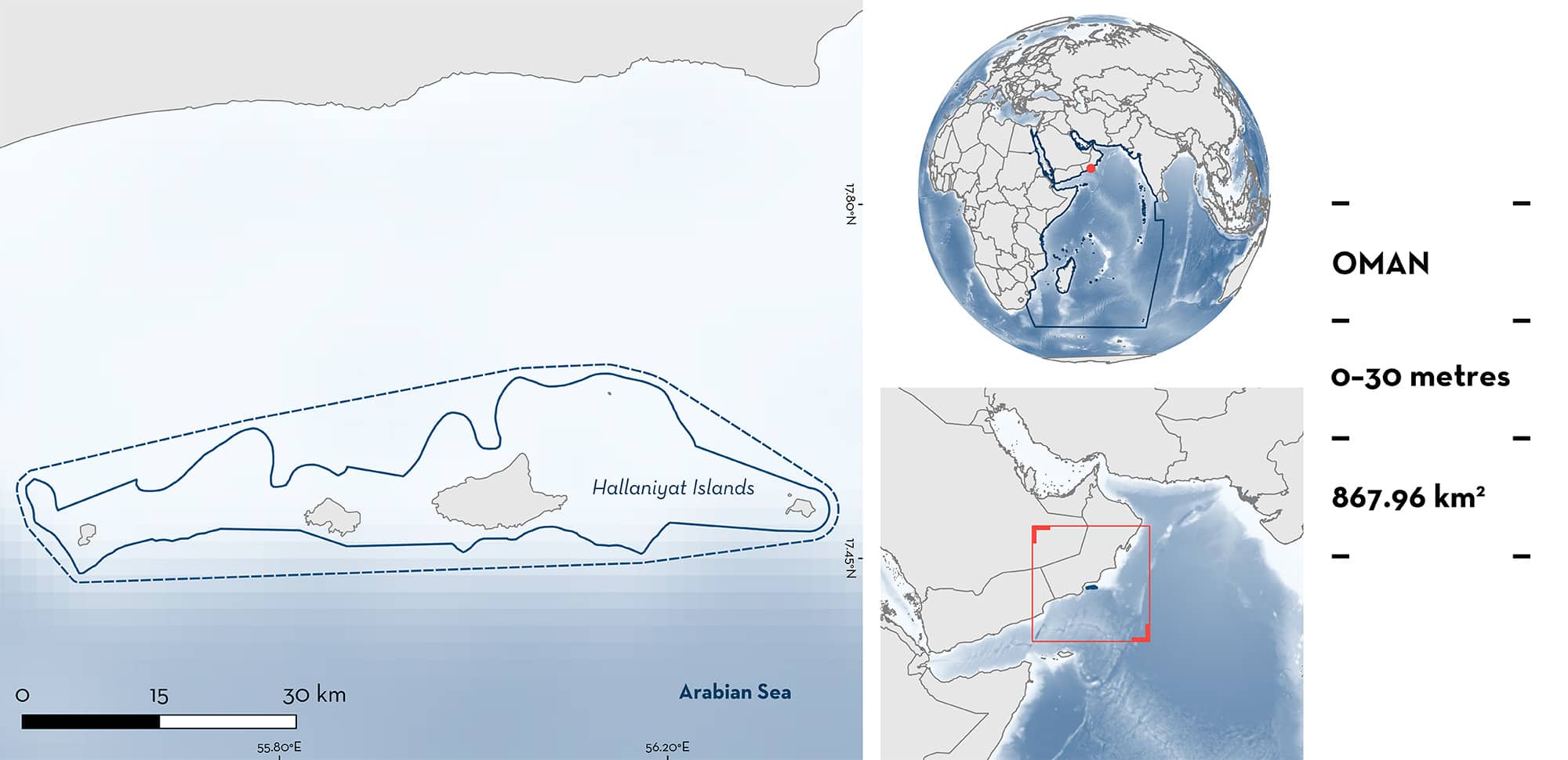ISRA FACTSHEETS
ISRA FACTSHEETS
WESTERN INDIAN OCEAN REGION
Hallaniyat Islands
Summary
Hallaniyat Islands is located off the southeastern coast of the Sultanate of Oman in the Arabian Sea. It is an archipelago made up of four main islands and small rocky islets. The habitat is characterised by rocky patches, coral reefs, and sandy substrates. The area overlaps with the Halaaniyaat Islands Key Biodiversity Area and the Oman Arabian Sea Ecologically or Biologically Significant Marine Area. Within this area there are: threatened species (e.g., Blotched Fantail Ray Taeniurops meyeni); range-restricted species (Oman Bullhead Shark Heterodontus omanensis); and undefined aggregations (e.g., Shorthorned Pygmy Devil Ray Mobula kuhlii).
Download factsheet
Hallaniyat Islands
DESCRIPTION OF HABITAT
Hallaniyat Islands is an archipelago made up of four main islands and small rocky islets. It is located in the Arabian Sea off the southeastern coast of the Sultanate of Oman, in the Dhofar Governorate. The habitat is characterised by rocky sublittoral mixed coral and brown algae, and coastal cliffs with predominantly sandy sublittoral substrates (UNESCO 2013). The area is mostly influenced by southwest monsoon winds (June–September) and northeast monsoon winds (December–April). Southwest monsoon season brings nutrient-rich deep waters to the surface producing plankton blooms along the Arabian Sea coast of Oman (AlBusaidi & Al-Hashmi 2023).
The area overlaps with the Halaaniyaat Islands Key Biodiversity Area (KBA 2023) and the Oman Arabian Sea Ecologically or Biologically Significant Marine Area (CBD 2023).
This Important Shark and Ray Area is benthopelagic and is delineated from inshore and surface waters (0 m) to 30 m based on the distribution of the Qualifying Species in the area.
CRITERION A
VULNERABILITY
Three Qualifying Species considered threatened with extinction according to the IUCN Red List of Threatened SpeciesTM regularly occur in the area. These are the Endangered Shorthorned Pygmy Devil Ray (Rigby et al. 2022), and the Vulnerable Reef Manta Ray (Marshall et al. 2022) and Blotched Fantail Ray (Kyne & White 2015).
CRITERION B
RANGE RESTRICTED
This area holds the regular presence of the Oman Bullhead Shark as a resident range-restricted species. This species has been observed by divers in the area on three occasions since 2018, once in December 2018, once in September 2019, and once in October 2019 at depths of 20 m (Oman Aggressor 2020). Records of this species are scarce and individuals have only been reported in Oman and Pakistan (Ebert et al. 2021). Hallaniyat Islands holds the most records for any single location, highlighting the global importance of this area for the species. This species occurs only in the Arabian Sea Large Marine Ecosystem.
CRITERION C
SUB-CRITERION C5 – UNDEFINED AGGREGATIONS
Hallaniyat Islands is an important area for undefined aggregations of four ray species.
Based on dive logbooks from 2018–2020, Reef Manta Ray aggregations were regularly observed in the area by divers from October to January, with a peak in November (Oman Aggressor 2020). From 199 dives (conducted from September to April), Reef Manta Rays were sighed on 36 dives with aggregations composed of up to 10 individuals. Although large aggregations occur in the Red Sea (Knochel et al. 2022a, 2022b), Reef Manta Ray aggregations in the Gulf of Aden, the Gulf of Oman, and the northwestern Arabian Sea are rarely reported, highlighting the importance of this area within the region. The presence of the species in the area has been confirmed across multiple years since 2009 as part of diving activities (Luis Masuet Expeditions 2009; Böhme 2014a, 2014b) confirming their regular and predictable occurrence. More information is needed to understand the nature and function of these aggregations.
Based on dive logbooks from 2018–2020, Shorthorned Pygmy Devil Rays were commonly observed by divers from November to April (Oman Aggressor 2020). From 199 dives (September–April), Shorthorned Pygmy Devil Rays were sighted on almost half of the dives. Individuals were regularly observed forming aggregations of 3–12 individuals, and occasionally of up to 30 individuals (Oman Aggressor 2020). More information is needed to understand the nature and function of these aggregations.
Based on dive logbooks from 2018–2020, Bluespotted Lagoon Rays are commonly observed year-round (Oman Aggressor 2020). From 199 dives (September–April), Bluespotted Lagoon Rays were sighted on 60 dives. Individuals are regularly observed forming aggregations of ~5 individuals, and occasionally of up to 12 individuals (Oman Aggressor 2020). More information is needed to understand the nature and function of these aggregations.
Based on diver logbooks from 2018–2020, Blotched Fantail Rays are commonly observed in the area year-round (Oman Aggressor 2020). From 199 dives (September–April), Blotched Fantail Rays were sighted on 63 dives. Individuals are regularly observed forming aggregations of 3–5 individuals, and occasionally dozens of individuals are reported together (Oman Aggressor 2020). One courtship/mating aggregation was observed, with two large females laying on the sand and 13 males hanging around them (Oman Aggressor 2020). However, more information is needed to understand the nature and function of these aggregations.
Download factsheet
SUBMIT A REQUEST
ISRA SPATIAL LAYER REQUEST
To make a request to download the ISRA Layer in either a GIS compatible Shapefile (.shp) or Google Earth compatible Keyhole Markup Language Zipped file (.kmz) please complete the following form. We will review your request and send the download details to you. We will endeavor to send you the requested files as soon as we can. However, please note that this is not an automated process, and before requests are responded to, they undergo internal review and authorization. As such, requests normally take 5–10 working days to process.
Should you have questions about the data or process, please do not hesitate to contact us.


